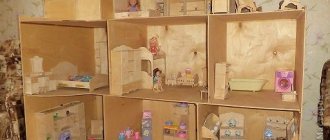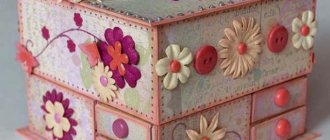In everyday life, all people use spoons, perhaps except for representatives of some Asian countries who prefer wooden sticks. And when the question arises about choosing this cutlery, many, without much hesitation, go to the store and buy them, focusing on their taste and budget.
A wooden spoon most often has a decorative function, but can also be used for its intended purpose.
More and more people are attracted to wooden utensils; they have a special flavor and are very pleasant to eat from. This article will talk about how to make a wooden spoon with your own hands, without much experience and with a minimum number of tools.
Necessary tool
First you need to decide what should be on hand to make wooden spoons:
- Block - not all species are equally good for making spoons; it is best to use aspen, birch, cedar or juniper. The log itself must be well dried;
- A marker - or a pencil, it will be needed to mark the contours of the future spoon on the workpiece;
- Ax - it is best to take a small hatchet; it is used to carry out the initial preparation of the block;
- Knife – should be comfortable and sharp; it will be needed for finer processing of the workpiece;
- Klukarz is a special figured chisel, it is distinguished by a modified shape of the working tip. To make spoons with your own hands, a cranberry with an arched tip is used;
- Sandpaper – for polishing the spoon;
- Flax oil – coating with linseed oil will serve as protection against the negative effects of water;
- Drill - a special ball-shaped attachment is sold for this for grinding rounded surfaces. You can also use a drill to drill a hole for a hook in the handle of a spoon.
The complexity of the original technology
Creating a real Khokhloma painting is not so easy, it is a very troublesome task, and the process is long. The blanks for painting are dried well in air and then in an oven to remove the last moisture.
First, the blanks are coated with at least two layers of primer - a liquid mixture of clay and oil. It is rubbed into the walls of the dishes, and then sent back to the drying oven. The primer is needed to close the pores in the wood. Next comes leveling the surface with sandpaper.
Now the products will not absorb moisture from the air. Khokhloma dishes will last a long time and will not crack. Now comes the coating with drying oil, you need to apply 2-3 layers, each drying for about 3 hours.
The last layer is not completely dried; it should not stain your hands, but at the same time remain sticky. Then the products are tinned - coated with metal powder. In the old days it was made of tin, but nowadays aluminum is used, since the last layer remains sticky and the powder rubs in easily.
For painting, Khokhloma craftsmen use brushes made from squirrel tails. With one brush you can draw both thin and thick lines; you just need to change the pressure.
They also use a “poke” - they use it to stamp small round berries or flowers. At the end of the work, the utensils are varnished, this gives the surface a golden shine, and not silver, as at the very beginning. This is followed by several more coatings, this time with colorless varnish.
Principles of gouache painting
As you can see, the process is very long, complex and energy-consuming. For “home use” it can be greatly simplified.
We can repeat the design of the famous folk painting on wooden objects, but this can be done much easier. Here we talk in detail about the technique with which you can paint a tree quite simply; the technology is simple, which is accessible even to beginners. Paints can be used both gouache and acrylic.
There are now a lot of metallic paints on store shelves, with gold, silver or copper tints, so let’s just create a background and simply paint.
Step-by-step instructions for making a wooden spoon with your own hands
Wood selection
In order for the spoon to be comfortable and practical, it is important to choose the right type of wood. You should look at hard types of wood so that your future spoon will last longer.
For the spoon you should choose cedar, aspen or juniper.
The ideal option would be a pre-prepared and dried birch or aspen log. If you make a spoon from raw wood, it will warp over time.
Preparing for work
In order to make a wooden spoon with your own hands, drawings and templates for its manufacture should be prepared in advance. Clarity of the process is the key to success in any business.
The place for manually making wooden spoons must be cleared of unnecessary items, leaving only what is necessary.
Workpiece characteristics
When making a wooden spoon from a block, you should remember that it must be of a certain size. For a tablespoon, a block measuring 300x100x60 mm will do, where the first number is the length, the second is the width, and the third is the thickness.
If you are using a log, cut it in half and roughly match the dimensions above.
Marking
Using a marker or pencil, carefully draw the contours of the future spoon according to the template. There can be many options, although you can come up with them yourself.
Primary processing
Using a hatchet, cut off any excess wood around the outlined contours of the spoon. Process the workpiece without reaching the edges of the spoon outlined with a marker, approximately 8-10 mm. This step is due to the fact that the wood fibers can be twisted after drying, and you will chip off the excess, thereby ruining the workpiece.
Cut the workpiece slightly larger than the markings, taking into account the finishing sanding of the product.
It is important to follow safety precautions! Working with an ax in the process of making spoons with your own hands is the most dangerous; inattention can lead to injuries. Watch your fingers before you hit the axe!
At the same time, try not to make a margin of more than 1 cm; the process of processing with a knife is more labor-intensive. The more accurately you prepare the workpiece using a hatchet. The less work there will be.
Cavity in spoon
Arm yourself with a cranberry and without a hammer, and relying only on the strength of your hands, begin to gradually select a “hole” in the workpiece. For more accurate work, it is better to draw the thickness of the walls. The best handmade masters have very thin walls, 4-5mm thick, but if this is your first work, then it’s better not to risk it and make the walls 7-8mm. You should go deeper, focusing on your own preferences and the thickness of the workpiece.
If you don’t have enough imagination, you can draw the circle of the recess by making a template taken from a finished wooden spoon. You can see the solution in the video attached to the post.
Processing with a knife
Secondary processing will give the wooden spoon an almost final look. The knife should have a short but sharp blade. Carefully cut off any excess. As mentioned above, you can give a wooden spoon the shape you want, the only limitations will be your imagination and the abilities of your hands.
Comment! If you are making a spoon with your own hands in nature for immediate purposes, then processing it with a knife will be quite enough; eating fish soup from roughly processed utensils is even more pleasant.
Many people make the mistake of cutting wood by pointing the knife at excess areas and hitting it with a hammer. This should not be done, due to the same twisted fibers. By doing this you risk damaging the spoon.
The easiest way to “pick” the hole in the spoon is with cranberries.
The shape of the handle can also be any; if you want to make a set of wooden spoons, then all standard elements should be in equal proportions, especially the handles. To do this, you should draw templates or download drawings from the Internet. Although an original template made by yourself will please the eye much more.
Processing the back of a wooden spoon is one of the most crucial moments. Many amateurs, when making their first sample by hand, try to make the spoon too elegant and remove the excess layer during the processing process.
Important to remember! Wood is a specific material, it is heterogeneous, it may contain knots or hidden cavities. When cutting the back side with a knife, be very careful, you can damage the spoon in the final stage of processing.
Internal surface treatment
For this, a special drill attachment is best suited; they come in different types. The essence of the treatment is to polish the concave surface of the spoon without damaging it.
If you don’t have a round nozzle, you can replace it with a rubber one with an attachment under the sandpaper petal. But in this case, be very careful during the grinding process; you cannot put pressure on the drill, otherwise the fastening bolt located in the middle of this attachment may leave deep grooves on the surface of the spoon.
To fix it, the spoon should be placed in a vice; holding it in your hands is very dangerous, because the drill can come off and injure you. But it is necessary to fix it with gaskets, this will avoid damage to the surface of the spoon by the jaws of the vice.
Sanding a spoon
One of the most enjoyable processes in making a spoon with your own hands. If you have little experience in working with wood, most likely, after processing with a knife, the spoon remains far from ideal. Sandpaper grades P240 to P280 will help remove unevenness; it is ideal for working with hard wood.
Sanding is the final stage of manufacturing and is performed with sandpaper.
Finer grinding should be done with grades P400 - P600; with their help, you can prepare the surface for painting or varnish.
Looking for differences
So let's look at a "factory" spoon. Here she is:
Beauty, isn't it? Let us also add that she can eat without fear for her health, since the products of artels are usually certified. Now, answer your question - you can distinguish it externally from this one:
An untrained person will never immediately determine the difference in appearance - especially since the price of products differs significantly. Factory ones cost two and sometimes three times more.
Let's take a closer look at them together and try to find the difference!
The difference in shapes immediately catches your eye - the factory one is rounder, and the home one is oblong. But that’s not the point, the preparation is just different. The main difference is the subtlety of the drawing. Let's take a closer look:
The branches and patterns on the golden petals are made with a thinner brush. And the sheer number of patterns on a factory spoon is much greater - compare, for example, the strawberry seeds on both spoons. The stems are drawn, the flower on the factory spoon is more full.
Now let's go down a little and look at the handle. The slight unevenness of the homemade spoon immediately catches your eye.
On the left, the handle is turned on a machine, and on the right, the handle is carved, hand-carved by a craftsman and a little crooked. Whether this is good or bad is up to you to decide, but we prefer to call it a feature :)
As soon as we take a closer look at a homemade spoon, facts become visible that prove its homemade, not factory origin.
Take a closer look at the place the red arrow points to. Do you see a small oblong spot? This is the place where the spoon was placed after being treated with varnish or paint. Those. the master painted the spoon and simply put it on the table. In a factory environment, where all the processes are streamlined and where there is quality control, this is not possible.
Noble craftswomen work at the factory. By the way, nothing prevents them from painting spoons at home, after work. Or, having gained experience at the enterprise, create your own production.
But let's return again to our beauties. Remember, in boxes of chocolates there was such a piece of paper with the inscription “Packer No. 5”? There is also a technical control department at Khokhloma enterprises. But how can you tell which artist painted a particular spoon if thousands of them are made every month? Using your own signature:
There are several artists working at the factory, so the “signature” on the spoons will be different, but its very presence indicates the factory origin of the product.
In addition to all the above differences, there is one more thing: a large organization cares about the labeling of its products. Therefore, the label on the original spoon with the name of the manufacturer and even possibly a barcode will also be a distinctive feature!
And the last thing, of course, is the price. A factory-made spoon should cost at least 100 rubles (as of the date of writing) from any retailer. Of course, there are some fruits that can charge so much for a clumsy “chernushka”, but the majority of sellers now are still focused on regular customers.
Water protection
A wooden spoon made by yourself will serve its owner for a long time if he promptly takes care of protecting it from exposure to water.
As you know, regular wetness causes wood to deteriorate! For coating, a variety of oils are used, linseed, tung and others. The choice lies with the manufacturer.
Treating a spoon with oil is not a difficult process at all, especially if you made a hole in its handle. In this case, you can completely process the spoon hanging by the hook. After drying, apply another layer of oil to its surface.
We hope the question of how to make a wooden spoon with your own hands has been completely resolved. As you can see, there is nothing complicated in this process, and perhaps making wooden utensils will become your new hobby.
Are there any fakes at all?
A good question: can a product that was historically made at home actually be counterfeited? No, of course there were special workshops, but in them, too, everything was not done on CNC machines, but by master turners and craftswomen artists, and they did everything with pens, with pens. How to find the original in such conditions? How to understand that this is a branded item, and this is a handicraft on the knee?
Let us tell you a great secret. At the moment, Khokhloma wooden spoons are made in factories, which in fact represent a really small team of craftsmen, and in home workshops (garage, garden plot). Therefore, in principle, such products cannot be divided into “original” and “fake”, but must be divided into “factory” and “homemade”. Naturally, they will differ both in appearance and in price.











